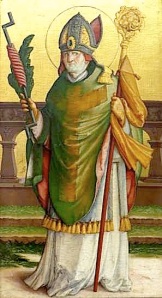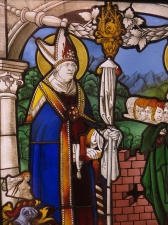 |
| The Martyrdom of Erasmus by Nicolas Possin |
St. Erasmus’s (also called Elmo) primary emblem is the windlass – a crank and shaft used for hoisting or hauling – so it is often assumed that the windlass had something to do with his martyrdom (maybe torn apart by one). Martyrs are often portrayed near or actually holding the instruments of their death; for example, Saint Stephen, who was stoned to death, may be shown holding a stone, or Saint Florian, who was drowned after being thrown into a river with a millstone around his neck, may be seen with a millstone. Saint Erasmus’s windlass, however, is emblematic of his patronage of mariners, not his manner of death. Still, the symbol of the windlass (a nautical symbol) and Saint Erasmus’s status as a martyr have become conflated over time, resulting in a gruesome, though erroneous, story of martyrdom by windlass.
Martyrdom of Saint Erasmus

Saint Erasmus was Bishop of Formiae, Campagna, Italy. The Roman Martyrology recounts that Saint Erasmus “was first scourged with leaded whips and then severely beaten with rods; he had also rosin, brimstone, lead, pitch, wax, and oil poured over him, without receiving any injury.” Later, during the reign of Maximian, “he was again subjected to various most horrible tortures at Mola, but was still preserved from death by the power of God for the strengthening of others in the faith. Finally, celebrated for his sufferings, and called by God, he closed his life by a peaceful and holy end. His body was afterwards transferred to Gaeta.”
Notably absent from the Roman Martyrology’s account is any mention of a windlass (an apparatus for moving heavy weights, developed by Archimedes), or a dramatic death. On the contrary, the martyrology states that Saint Erasmus died “by a peaceful and holy end.” Over the centuries, however, Saint Erasmus’s frequent portrayal with a windlass and his status as a martyr gave rise to the myth that he had been killed with the use of a windlass. More specifically, and as portrayed to grisly effect in art, a tradition arose that he was disemboweled and that his intestines were wound around a windlass as he was killed.
As Patron Saint of Sailors

As mentioned, the windlass became a symbol of Saint Erasmus because of his patronage of sailors. During storms at sea, sailors sometimes encountered blue glowing balls of light or blue flames springing from the mastheads of their ships. Because these lights often appeared toward the end of a storm, sailors considered the lights a good omen and a sign of protection from their patron saint. The name “Erasmus” had several variants around the Mediterranean, including “Elmo,” and the lights became known as “St. Elmo’s Fire” or “St. Elmo’s Lights.” St. Elmo’s Fire is a meteorological phenomenon caused by ionization of the air around certain objects, like ships’ masts. Nitrogen and oxygen in the atmosphere fluoresce, like gas in a neon light, with a blue or violet glow, giving St. Elmo’s Fire its distinctive hue.
St. Elmo's Fire (you've heard of it)
An electrical phenomenon that causes a blue aura to emanate from certain structures during times of high static electricity. St. Elmo's Fire is often seen by sailors on ships at sea during stormy weather. Sailors in centuries past believed it was a good omen. St Elmo's Fire is known to have caused a high degree of intelligence to be possessed by person's known to have it course through their body.
St. Elmo's Fire is a type of continuous electric spark called a "glow discharge." You've seen it many times before, since it is almost exactly the same as the glows found inside fluorescent tubes, mercury vapor streetlights, old orange-display calculators and in "eye of the storm" plasma globes. When it occurs naturally, we call it St. Elmo's Fire, but when it occurs inside a glass tube, we call it a neon sign. St. Elmo's Fire and normal sparks both can appear when high electrical voltage affects a gas. St. Elmo's fire is seen during thunderstorms when the ground below the storm is electrically charged, and there is high voltage in the air between the cloud and the ground. The voltage tears apart the air molecules and the gas begins to glow. It takes about 30,000 volts per centimeter of space to start a St. Elmo's fire (although sharp points can trigger it at somewhat lower voltage levels.)
Disembowelment By Windlass
Over time, however, Saint Erasmus’s nautical emblem began to take on a more sinister pall. As Rosa Giorgi states in Saints In Art, even though no written evidence held that Saint Erasmus’s intestines were “pulled from his body with a windlass,” the windlass nevertheless “became popularly imagined as an instrument of torture, and thus the atrocious punishment of having one’s intestines extracted with the device was invented.” Giorgi further explains, “This is one example where imagery influenced hagiography.”
As Portrayed in Art
Nicholas Poussin’s The Martyrdom of Saint Erasmus (1628) (pictured at the beginning of this post) perpetuates the myth that Saint Erasmus was disemboweled. The painting is fraught with tension and high drama as Saint Erasmus, his face pained but resolute, is methodically disemboweled while a crowd of his tormentors looks on. Saint Erasmus, who is tied down on his back over a sturdy wooden bench, anchors the scene. His red chasuble and miter, indicating his status as a bishop, are strewn on the ground beside him. His executioner, whose head is positioned near the very center of the painting, leans over him, pulling his intestines from his body. A man in the background to the right of the painting pulls a windlass, winding the intestines around a wooden post.
To the left of the painting, a man in white stares angrily into Saint Erasmus’s face and gesticulates towards a pagan statute crowned with laurel leaves. The man is demanding that Saint Erasmus forsake his faith. Two angels hover above, carrying a laurel wreath and a palm frond, which were symbols of victory to the Romans. Christian artists later appropriated those symbols, particularly the palm frond, and used them to represent a martyr’s victory over death. In The Martyrdom of Saint Erasmus, the angels wait to bestow the crown and palm frond of martyrdom on Saint Erasmus in his final hour.
Other Associations
In addition to being the patron saint of sailors, Saint Erasmus is also the patron saint of a host of other groups, including explosives workers, ordnance workers, and women in labor. He is also invoked against colic, birth pains, intestinal disorders, stomach diseases, and storms. He is one of the Fourteen Holy Helpers, a group of saints regarded as special protectors against various illnesses.


No comments:
Post a Comment